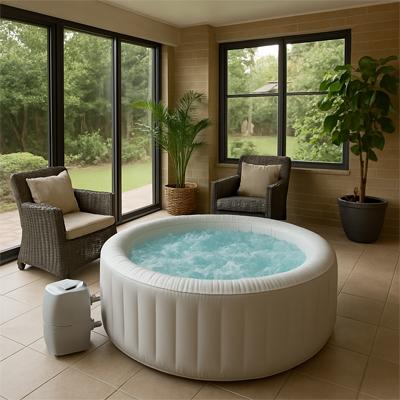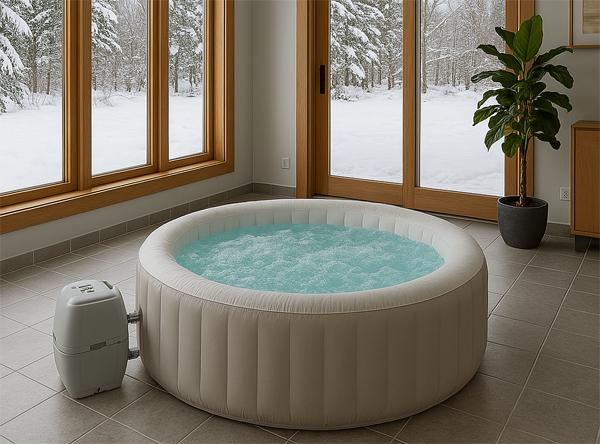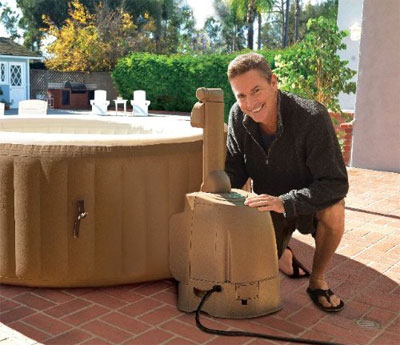Yes, you can use an inflatable hot tub in winter. However, the colder the outdoor air temperature is, the harder the hot tub will have to work heat up and stay warm.

Most inflatable hot tubs are designed to operate at outdoor temperatures down to about 40°F (4.4°C). So, if you live in an extremely cold winter climate, and inflatable spa may not be the best option for wintertime use.
How to Maximize Hot Tub Heater Efficiency:
As we mentioned above, the colder the air temperature, the more energy the spa will need to heat up. Therefore, it makes sense to make it more energy efficient if you want to use it during the winter.
Not only will better efficiency help you save money on heating bills, it can help prolong the life of your hot tub heater. Here are 5 tips for you:
1. Insulate the Bottom of Your Spa: Many inflatable hot tubs come with some sort of floor mat to help retain heat. However, you can also get a foam floor pad or use a few layers of cardboard to help insulate the base.
2. Cover Your Hot Tub When Not in Use: Most inflatable hot tubs include a cover which can significantly reduce heat loss. In addition, covers lessen water loss through evaporation, and they help keep debris out of the spa.
3. Use a Thermal Blanket: A thermal blanket sits on top of the water to prevent heat loss through evaporation. Therefore, you don’t need to use as much energy to heat the water.
4. Create a Windbreak: You can further insulate your inflatable spa by placing it in a protected location, For example, on a deck or patio where it has vertical protection on multiple sides – or a roof overhead.
5. Keep the Hot Tub Clean: Dirty water makes it harder for the filtration/heating system to heat the water. So, rinse and change filters on a regular basis and prevent leaves and other debris from blowing into the spa.
Using Inflatable Spas in Winter: Cold or Indoor Setups

While inflatable hot tubs can be used during the winter months, their performance and longevity really depend on the climate and how well they’re insulated. In areas where temperatures regularly drop below freezing, the built-in heating system of most inflatable models may struggle to maintain the set temperature, especially if the tub is exposed to wind and snow.
That’s why pairing your inflatable spa with extra insulation—like an insulated base mat, a thermal blanket, and a weather-protective gazebo—can make a noticeable difference in performance. It’s also a good idea to preheat the spa a day in advance during especially cold weeks and keep it covered when not in use to reduce heat loss.
If you’re considering using an inflatable hot tub indoors during the winter, that can be a smart move—especially if you have a sunroom, basement, or enclosed patio that stays above 40°F. Indoor use allows for better heat retention and protects your spa from snow, rain, and ice buildup. But be mindful of the weight of the filled spa, which can be over 1,800 pounds.
You’ll need a waterproof floor, a nearby drain or wet vacuum for maintenance, and good airflow to prevent humidity from causing mold or mildew in your space. A dehumidifier is a great addition for long-term indoor use.
In terms of better spa options for year-round or cold-climate use, plug-and-play hard-sided spas or rotomolded models provide much better insulation and reliability than inflatable spas. These typically include molded seating, stronger jet systems, and foam insulation that keeps water warmer with less energy use.

Although they’re more expensive and heavier to set up, they can operate in sub-freezing conditions without the same strain on the heating system. For anyone planning to use their spa frequently throughout the winter, the extra upfront investment often pays off in performance, energy efficiency, and comfort.
That said, inflatable hot tubs are still a great entry-level choice for mild to moderately cold climates, especially when enhanced with a protective structure and good thermal accessories. They offer flexibility, easy setup, and lower costs—making them ideal for renters or homeowners not ready to commit to a permanent installation.
Just make sure to follow all winter maintenance best practices, like keeping the spa running continuously during freezing conditions and never letting the water freeze inside the pump lines. With the right prep and protection, an inflatable hot tub can deliver cozy, bubbling comfort even when the snow starts to fall.
Last Updated April 7, 2025


